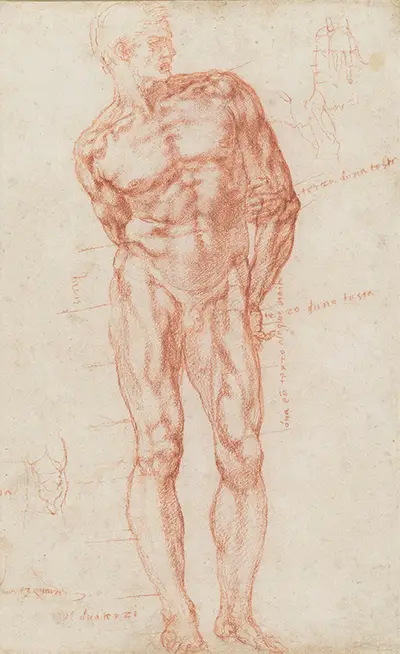The artwork found here was titled A Male with Proportions Indicated, once translated from the original Italian used by the artist. It is a study piece that actually captures the whole figure, where as normally he would focus just on a single limb or head. Perhaps this sketch followed a series of earlier works that took on individual elements of this same figure, with Michelangelo then putting them all together here. The muscles in this piece ripple in an extraordinary fashion, with the shoulders, chest and thighs being particularly strong and muscular. Besides the figure we find some interesting additions, essentially notes left by the artist as he considered the proportions of his portrait in relation to each other. This helps us to understand yet more about his working processes, as even though he was amongst the most researched artist in history, there is still plenty more to learnt about him.
Red chalk is used here, in two different shades. On the other side, known as the verso, is an additional artwork. This was common for the Renaissance, where every inch of paper would be used for sketching purposes in order to make the most of this precious resource. In some examples of the drawings of Da Vinci, for example, he would put seven or eight different limbs all on the same page. Michelangelo also did similar, such as in his preparation for the Last Judgement mural, in this early study drawing. All of that explains why the drawing in front of us is both rare but also highly valuable, with it serving as a genuine, completed artwork in its own right. Many of his sketches were kept together in impressive collections during his own lifetime and shortly afterwards, before later being sold off separately in order to maximise their individual value.
The drawing here is dated between 1515-1520 and his drawings were particularly hard to place within his career because very little documentation would have been made about them. It was only really when he produced them for an upcoming painting or sculpture could we then be more confident in giving a precise year of creation. Michelangelo would impress emotion within his human depictions, which would sometimes result in over-powering figures. Some have argued this drawing was actually produced for Sebastiano del Piombo who was a keen and talented follower of Michelangelo. They were collaborating together during this period, so it is quite possible. Many masters would produce drawings for their studio's benefit, being passed around assistants for educational and guidance purposes. It was essential to keep a consistent look throughout the studio, to avoid inconsistencies within major projects, where a number of different artists would work together.



